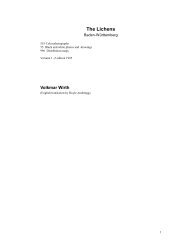Lichen communities in the British Isles: A preliminary conspectus
Lichen communities in the British Isles: A preliminary conspectus
Lichen communities in the British Isles: A preliminary conspectus
You also want an ePaper? Increase the reach of your titles
YUMPU automatically turns print PDFs into web optimized ePapers that Google loves.
308 P. W. James, D- L. Ilawkszporth and F. Rose<br />
This association rvas described by Hilitzer (1925) for cornmunitics don.ri<br />
natecl by calicium ztiride and <strong>in</strong> u-hich r,ecanactis altietirm was oftcn ,<br />
major component. In <strong>the</strong> .<strong>British</strong> <strong>Isles</strong> this generally spccies-poor assr.,ciir<br />
tion occurs on dry, rough or moderatcly smooth (e.g. Acer) bark or clrci<br />
duous trees <strong>in</strong> lowland areas (most frequently <strong>in</strong> those subjccted to moclcral,<br />
air pollution) and also on coniferous trees <strong>in</strong> central and castern Scotlantl<br />
<strong>communities</strong> dom<strong>in</strong>ated by Lecanactis abiet<strong>in</strong>a appear clist<strong>in</strong>ct frorn tl r<br />
cali.cietum hy1>erelli <strong>in</strong> <strong>the</strong> <strong>British</strong> <strong>Isles</strong> and that specics is rarely a n'rajt,<br />
componcnt of this association here. Lecanctra expallens, Lecidea scaluri<br />
Lepraria <strong>in</strong>cana., sometimes Buellia schaereri (central and eastern Scotlancl<br />
Catillaria grffithii and schismatomma decolorans, entcr this associati.<br />
but it most commonly consists of almost pure stands of calicium salic<strong>in</strong>trti<br />
C. ztiride, Chaeno<strong>the</strong>ca ferrug<strong>in</strong>ea and Le.praria candelaris. Chaerufilrct<br />
ferrug<strong>in</strong>ea predorn<strong>in</strong>ates <strong>in</strong> polluted areas whilst Schismatomma xirghtert,<br />
occurs <strong>in</strong> <strong>the</strong> driest facies ofthis association.<br />
ln lovvland Brita<strong>in</strong> <strong>the</strong> Calicietttm hyperelli is most commonly fountl r,<br />
<strong>the</strong> dry (usually north-east) sides of u'ell lit deciduous trees which car.r<br />
ci<strong>the</strong>r <strong>the</strong> Parmelion perlatae or Xanthorion pariet<strong>in</strong>ae on <strong>the</strong>ir better- l<br />
and wetter sides. Allied to this association is a fur<strong>the</strong>r casily ovcrlookt<br />
community u'hich may be dist<strong>in</strong>ct, which occurs <strong>in</strong> dry sheltered bar<br />
crevices of ra<strong>the</strong>r basic-barked trecs (e.g. F'rax<strong>in</strong>us, Salix, (,'lmus) particr<br />
larly <strong>in</strong> south-east England and central Scotland. 'I'his community<br />
dom<strong>in</strong>ated by Chaeno<strong>the</strong>ca trichialis togethcr with C. hispidula, C. curtlt,<br />
siae, C. laeoigata and Cont)ocyhe sulphurea.<br />
C o ni o c y b e tum furfur ac e a e Kalb<br />
Ber. bayer. bot. Ges. 41,70 (1969).<br />
The Coniocybetum,furfuraceae, characterized by abundant Coniot',t'i<br />
furfuracea, occurs <strong>in</strong> more shaded sites than <strong>the</strong> Calicietttm hltperclli al<br />
when on trees is restricted to basal crevices, exposed roots etc. 'l'lr<br />
association is not exclusively corticolous ancl also occurs on soft hurrr<br />
and <strong>in</strong> rock creviccs where it is protected from direct ra<strong>in</strong>. The Coniot_,<br />
betum furfuraceae is ma<strong>in</strong>ly restricted to rvestern and nor<strong>the</strong>rn parts of tl<br />
<strong>British</strong> <strong>Isles</strong>, When on rock this association may <strong>in</strong>clude elements of tl<br />
Micnreetum sylxtlcolae (p. 366) and its relationships to that comnrnnir<br />
nrerit fur<strong>the</strong>r study.<br />
Lec anac tidetum abiet<strong>in</strong>ae Hrl.<br />
Spisy Pfirod. Fac- Karl. Unia.4l,9+ (1925) fas "Association i. Leca.nott<br />
a.biet<strong>in</strong>a."l.<br />
10. <strong>Lichen</strong> Communr'.ties <strong>in</strong> <strong>the</strong> llritish l.rles 309<br />
Comrnunities dom<strong>in</strong>ated by Lecanactis abiet<strong>in</strong>a occur <strong>in</strong> gencrally sirniLrr<br />
habitats to <strong>the</strong> Calicietum hyperelli but favour somcu'hzrt r-r-rore shadcci<br />
and htrmid situations, for examplc dry, very acid bark of [t<strong>in</strong>us or Ouercu.r<br />
with<strong>in</strong> a wood ra<strong>the</strong>r than isolatecl trees <strong>in</strong> pastures. The zrssociation can<br />
perhaps be viewed as a dry bark counterpart of <strong>the</strong> Parmelietum laeaigatae.<br />
Where this association is optimally developed, <strong>the</strong> L. abiet<strong>in</strong>a rvith apo<strong>the</strong>cia,<br />
Calicium r:iride is often completely absent, ar-rd while Clmenotlteca .ferrug<strong>in</strong>ea<br />
is often to be found <strong>in</strong> <strong>the</strong> vic<strong>in</strong>ity, it tends to be on slightly less<br />
sheltercd parts of <strong>the</strong> trunks and to represent a fragment of <strong>the</strong> Calicietum<br />
hyperelli ra<strong>the</strong>r than form<strong>in</strong>g a part of <strong>the</strong> present association. The<br />
Lecanactidetmt abiet<strong>in</strong>ae is ra<strong>the</strong>r poor <strong>in</strong> specics <strong>in</strong> thc Ilritish Islcs<br />
although Lepraria <strong>in</strong>cana and Schismatommtt decolorans nray occur <strong>in</strong> it<br />
from time to time. Arthonia leucopellaea, Lecana.ctis amylocea and somctimes<br />
1,. corticola or L. d.ryophila, are rare members of this association<br />
occurr<strong>in</strong>g <strong>in</strong>, for example, south-u'estern ancl north-eastcrn Scotland ancl<br />
<strong>the</strong> Nerv Forest. In old r,r,oodland areas Schismatomma nioeum is also a<br />
frequent member of this association.<br />
Lecanactidetum premneae ass. nov. (Table I, F-ig. 2)<br />
This very dist<strong>in</strong>ctivc association, lhc " Schisma.tontme decolorans-Lecanactis<br />
premnea--Opegrapha lyncea community" of Rose and Jamcs (1974),<br />
appears to ultimately become <strong>the</strong> post-cl<strong>in</strong>lax commur)ity of very ancicnt<br />
(over 300 years) Ouercu.r trees ancl can cover <strong>the</strong>ir entire surfaces both <strong>in</strong><br />
open parklands ancl <strong>in</strong> forested areas (e.g. thc Ner,v Forcst) <strong>in</strong> southcrn<br />
Brita<strong>in</strong>. It colonizcs bark surfaces which have bccome dry and brittle lvith<br />
age and lost <strong>the</strong>ir water-hold<strong>in</strong>g capacity but reta<strong>in</strong>ed a rclativcly high pIJ.<br />
Though an association clearly relict from ancient forcsts, it does not nccd<br />
a forest microclimate to survive and can occllr on ancicnt, nou' isolatccl,<br />
trees. 'Ihe association is unknown <strong>in</strong> Scotland and appears very rarcly <strong>in</strong><br />
Ireland.<br />
The characteristic species of <strong>the</strong> Lecanactidehtm ?remneae are Lecanactis<br />
premnea, Opegral>ha lyncea, O. prosodea (extreme south of England only),<br />
Schisnmtotnma decolorans, and sometimcs S. r:irg<strong>in</strong>eum. Arthonia impolita<br />
and Buellia canescens are sometimes present <strong>in</strong> pasture sitcs. Although<br />
almost entirely restricted to agcd Quercus (though also known on agccl<br />
Fagus), a facies of this association (lack<strong>in</strong>g O. lyncea) occurs on extremcly<br />
ancient Taxus trees (usually <strong>in</strong> churchyards).<br />
This community has been littlc understood <strong>in</strong> <strong>the</strong> past, doubtless duc tcr<br />
tlre scarcity of ancient Quercus trees outsidc <strong>the</strong> <strong>British</strong> <strong>Isles</strong>, but elemcr.rts<br />
of it wcre <strong>in</strong>cludcd by Barkman (1958) <strong>in</strong> his ra<strong>the</strong>r broad concept of <strong>the</strong>





